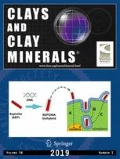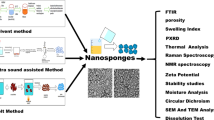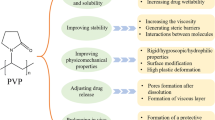Abstract
Halloysite nanotubes (HNTs) have attracted much attention as delivery carriers for various drugs, but the loading of one such drug, quercetin, on HNTs has been investigated only rarely and usually involved cyclic vacuum pumping. The main objective of the present study was to develop a novel carrier system based on HNTs for quercetin delivery without a vacuum process and to investigate the effect of chemical modification of HNTs on the loading and release of quercetin. For this purpose, comparative studies of five chemical modification reagents (sodium lauroamphoacetate, cocoamidopropyl betaine, 1-hydroxyethyl 2-nonyl imidazoline betaine, triethanolamine, and dipicolinic acid) functionalized on HNTs were investigated for quercetin loading and in vitro release. Characterization of raw halloysite, modified halloysite, and quercetin-loaded halloysite were done by X-ray diffraction (XRD), Fourier-transform infrared spectrometry (FTIR), thermogravimetric analysis (TGA), and transmission electron microscopy (TEM). The results indicated that chemical modification could improve the interactions between HNTs and quercetin. After chemical modification, quercetin was anchored to both the inner and outer surfaces of HNTs by electrostatic attraction, hydrogen bonding, and van der Waals forces. Sodium lauroamphoacetate-modified HNTs were given the highest loading of 1.96 wt.% among the five reagents. Cocamidopropyl betaine-modified HNTs exhibited the best sustained-release profile with only 29.07% for initial burst release and 480 h of consecutive release. Carboxyl groups of the modification reagent improved the loading capacity of quercetin. Amide groups prolonged drug release due to the strong affinity between amine and phenolic hydroxyl groups of quercetin. The release of quercetin from the cocamidopropyl betaine-modified HNTs fitted a first-order kinetics model well. The present study suggested that cocamidopropyl betaine-modified HNTs offer promise as vehicles for delivery of quercetin and for extending the application of quercetin.









Similar content being viewed by others
REFERENCES
Aguzzi, C., Cerezo, P., Viseras, C., & Caramella, C. (2007). Use of clays as drug delivery systems: Possibilities and limitations. Applied Clay Science, 36, 22–36.
Aguzzi, C., Viseras, C., Cerezo, P., Salcedo, I., Sanchez-Espejo, R., & Valenzuela, C. (2013). Release kinetics of 5-aminosalicylic acid from halloysite. Colloids Surface B: Biointerfaces, 105, 75–80.
Avila, L. R., de Faria, E. H., Ciuffi, K. J., Nassar, E. J., Calefi, P. S., Vicente, M. A., & Trujillano, R. (2010). New synthesis strategies for effective functionalization of kaolinite and saponite with silylating agents. Journal of Colloid and Interface Science, 341, 186–193.
Ben Salah, I., Sdiri, A., Ben M'barek Jemai, M., & Boughdiri, M. (2018). Potential use of the Lower Cretaceous clay (Kef area, northwestern Tunisia). as raw material to supply ceramic industry. Applied Clay Science, 161, 151–162.
Bobos, I., Duplay, J., Rocha, J., & Gomes, C. (2001). Kaolinite to halloysite-7 Å transformation in the kaolin deposit of São Vicente de Pereira, Portugal. Clays and Clay Minerals, 49, 596–607.
Cavallaro, G., Chiappisi, L., Pasbakhsh, P., Gradzielski, M., & Lazzara, G. (2018). A structural comparison of halloysite nanotubes of different origin by small-angle neutron scattering (SANS) and electric birefringence. Applied Clay Science, 160, 71–80.
Cheng, H., Liu, Q., Yang, J., Zhang, J., & Frost, R. L. (2010). Thermal analysis and infrared emission spectroscopic study of halloysite–potassium acetate intercalation compound. Thermochimica Acta, 511, 124–128.
de Faria, E. H., Lima, O. J., Ciuffi, K. J., Nassar, E. J., Vicente, M. A., Trujillano, R., & Calefi, P. S. (2009). Hybrid materials prepared by interlayer functionalization of kaolinite with pyridine-carboxylic acids. Journal of Colloid and Interface Science, 335, 210–215.
de Faria, E. H., Ciuffi, K. J., Nassar, E. J., Vicente, M. A., Trujillano, R., & Calefi, P. S. (2010). Novel reactive amino-compound: Tris(hydroxymethyl)aminomethane covalently grafted on kaolinite. Applied Clay Science, 48, 516–521.
Dedzo, G. K., Letaief, S., & Detellier, C. (2012). Kaolinite-ionic liquid nanohybrid materials as electrochemical sensors for size-selective detection anions. Journal of Materials Chemistry, 22, 20593–20601.
Dian, L. H., Yu, E. J., Chen, X. N., Wen, X. G., Zhang, Z. Z., Qin, L. Z., Wang, Q. Q., Li, G., & Wu, C. B. (2014). Enhancing oral bioavailability of quercetin using novel soluplus polymeric micelles. Nanoscale Research Letters, 9, 684–695.
Du, M., Guo, B., & Jia, D. (2010). Newly emerging applications of halloysite nanotubes: A review. Polymer International, 59, 574–582.
Franco, F., & Cruz, M. D. R. (2002). High-temperature X-ray diffraction, differential thermal analysis and thermogravimetry of the kaolinite-dimethylsulfoxide intercalation complex. Clays and Clay Minerals, 50, 47–55.
Frost, R. L., & Kloprogge, J. T. (1999). Raman spectroscopy of the low-frequency region of kaolinite at 298 and 77 K. Applied Spectroscopy, 53, 1610–1616.
Frost, R. L., & Shurvell, H. F. (1997). Raman microprobe spectroscopy of halloysite. Clays and Clay Minerals, 45, 68–72.
Guo, C., Yang, C., Li, Q., Tan, Q., Xi, Y., Liu, W., & Zhai, G. (2012). Development of a quercetin-loaded nanostructured lipid carrier formulation for topical delivery. International Journal of Pharmaceutics, 430, 292–298.
Hanif, M., Jabbar, F., Sharif, S., Abbas, G., Farooq, A., & Aziz, M. (2018). Halloysite nanotubes as a new drug-delivery system: A review. Clay Minerals, 51, 469–477.
Hári, J., Polyák, P., Mester, D., Mičušík, M., Omastová, M., Kállay, M., & Pukánszky, B. (2016). Adsorption of an active molecule on the surface of halloysite for controlled release application: Interaction, orientation, consequences. Applied Clay Science, 132–133, 167–174.
Hemmatpour, H., Haddadi-Asl, V., & Roghani-Mamaqani, H. (2015). Synthesis of pH-sensitive poly (N,N-dimethylaminoethyl methacrylate)-grafted halloysite nanotubes for adsorption and controlled release of DPH and DS drugs. Polymer, 65, 143–153.
Hollman, P. C., & Katan, M. B. (1999). Dietary flavonoids: Intake, health effects and bioavailability. Food and Chemical Toxicology, 37, 937–942.
Karunadasa, K. S. P., Manoratne, C. H., Pitawala, H. M. T. G. A., & Rajapakse, R. M. G. (2019). Thermal decomposition of calcium carbonate (calcite polymorph). as examined by in-situ high-temperature X-ray powder diffraction. Journal of Physics and Chemistry of Solids, 134, 21–28.
Kodama, H., & Oinuma, K. (1963). Identification of kaolin minerals in the presence of chlorite by X-ray diffraction and infra-red adsorption spectra. Clays and Clay Minerals, 11, 236–249.
Kumari, A., Yadav, S. K., Pakade, Y. B., Singh, B., & Yadav, S. C. (2010). Development of biodegradable nanoparticles for delivery of quercetin. Colloids and Surfaces B: Biointerfaces, 80, 184–192.
Kuo, S. M. (1996). Antiproliferative potency of structurally distinct dietary flavonoids on human colon cancer cells. Cancer Letters, 110, 41–48.
Lazzara, G., Cavallaro, G., Panchal, A., Fakhrullin, R., Stavitskaya, A., Vinokurov, V., & Lvov, Y. (2018). An assembly of organic-inorganic composites using halloysite clay nanotubes. Current Opinion in Colloid & Interface Science, 35, 42–50.
Lee, K. W., Kang, N. J., Heo, Y. S., Rogozin, E. A., Pugliese, A., Hwang, M. K., Bowden, G. T., Bode, A. M., Lee, H. J., & Dong, Z. (2008). Raf and mek protein kinases are direct molecular targets for the chemopreventive effect of quercetin, a major flavonol in red wine. Cancer Research, 68, 946–955.
Lee, Y., Jung, G. E., Cho, S. J., Geckeler, K. E., & Fuchs, H. (2013). Cellular interactions of doxorubicin-loaded DNA-modified halloysite nanotubes. Nanoscale, 5, 8577–8585.
Letaief, S., & Detellier, C. (2007). Functionalized nanohybrid materials obtained from the interlayer grafting of aminoalcohols on kaolinite. Chemical Communications, 25, 2613–2615.
Letaief, S., Tonle, I. K., Diaco, T., & Detellier, C. (2008). Nanohybrid materials from interlayer functionalization of kaolinite. Application to the electrochemical preconcentration of cyanide. Applied Clay Science, 42, 95–101.
Li, X., Yang, Q., Ouyang, J., Yang, H., & Chang, S. (2016). Chitosan modified halloysite nanotubes as emerging porous microspheres for drug carrier. Applied Clay Science, 126, 306–312.
Li, Y., Zhang, Y., Zhang, Y., Liu, M., Zhang, F., & Wang, L. (2017). Thermal behavior analysis of halloysite selected from Inner Mongolia autonomous region in China. Journal of Thermal Analysis and Calorimetry, 129, 1333–1339.
Lisuzzo, L., Cavallaro, G., Milioto, S., & Lazzara, G. (2019). Layered composite based on halloysite and natural polymers: A carrier for the ph controlled release of drugs. New Journal of Chemistry, 43, 10887–10893.
Lun, H., Ouyang, J., & Yang, H. (2014). Natural halloysite nanotubes modified as an aspirin carrier. RSC Advances, 4, 44197–44202.
Massaro, M., Piana, S., Colletti, C. G., Noto, R., Riela, S., Baiamonte, C., Giordano, C., Pizzolanti, G., Cavallaro, G., Milioto, S., & Lazzara, G. (2015). Multicavity halloysite–amphiphilic cyclodextrin hybrids for co-delivery of natural drugs into thyroid cancer cells. Journal of Materials Chemistry B, 3, 4074–4081.
Massaro, M., Riela, S., Guernelli, S., Parisi, F., Lazzara, G., Baschieri, A., Valgimigli, L., & Amorati, R. (2016). A synergic nanoantioxidant based on covalently modified halloysite-trolox nanotubes with intra-lumen loaded quercetin. Journal of Materials Chemistry B, 4, 2229–2241.
Matusik, J., & Wścisło, A. (2014). Enhanced heavy metal adsorption on functionalized nanotubular halloysite interlayer grafted with aminoalcohols. Applied Clay Science, 100, 50–59.
Matusik, J., Gaweł, A., Bielańska, E., Osuch, W., & Bahranowski, K. (2009). The effect of structural order on nanotubes derived from kaolin-group minerals. Clays and Clay Minerals, 57, 452–464.
Mei, D., Zhang, B., Liu, R., Zhang, H., & Liu, J. (2011). Preparation of stearic acid/halloysite nanotube composite as form-stable pcm for thermal energy storage. International Journal of Energy Research, 35, 828–834.
Natarajan, V., Krithica, N., Madhan, B., & Sehgal, P. K. (2011). Formulation and evaluation of quercetin polycaprolactone microspheres for the treatment of rheumatoid arthritis. Journal of Pharmaceutical Sciences, 100, 195–205.
Panda, A. K., Mishra, B. G., Mishra, D. K., & Singh, R. K. (2010). Effect of sulphuric acid treatment on the physico-chemical characteristics of kaolin clay. Colloids and Surfaces A: Physicochemical and Engineering Aspects, 363, 98–104.
Paul, D. R. (2011). Elaborations on the higuchi model for drug delivery. International Journal of Pharmaceutics, 418, 13–17.
Pereira, A. B., Silva, A. M.d., Barroca, M. J., Marques, M. P. M., & Braga, S. S. (2020). Physicochemical properties, antioxidant action and practical application in fresh cheese of the solid inclusion compound γ-cyclodextrin·quercetin, in comparison with β-cyclodextrin·quercetin. Arabian Journal of Chemistry, 13, 205–215.
Pool, H., Mendoza, S., Xiao, H., & McClements, D. J. (2013). Encapsulation and release of hydrophobic bioactive components in nanoemulsion-based delivery systems: Impact of physical form on quercetin bioaccessibility. Food & Function, 4, 162–174.
Qi, Y., Jiang, M., Cui, Y.-L., Zhao, L., & Zhou, X. (2015). Synthesis of quercetin loaded nanoparticles based on alginate for Pb(II) adsorption in aqueous solution. Nanoscale Research Letters, 10, 1–9.
Santos, A. C., Pereira, I., Reis, S., Veiga, F., Saleh, M., & Lvov, Y. (2019). Biomedical potential of clay nanotube formulations and their toxicity assessment. Expert Opinion on Drug Delivery, 16, 1169–1182.
Seifi, S., Diatta-Dieme, M. T., Blanchart, P., Lecomte-Nana, G. L., Kobor, D., & Petit, S. (2016). Kaolin intercalated by urea. Ceramic applications. Construction and Building Materials, 113, 579–585.
Tan, D., Yuan, P., Annabi-Bergaya, F., Liu, D., Wang, L., Liu, H., & He, H. (2014). Loading and in vitro release of ibuprofen in tubular halloysite. Applied Clay Science, 96, 50–55.
Vikulina, A., Voronin, D., Fakhrullin, R., Vinokurov, V., & Volodkin, D. (2020). Naturally derived nano- and micro-drug delivery vehicles: Halloysite, vaterite and nanocellulose. New Journal of Chemistry, 44, 5638–5655.
Vinokurov, V. A., Stavitskaya, A. V., Chudakov, Y. A., Ivanov, E. V., Shrestha, L. K., Ariga, K., Darrat, Y. A., & Lvov, Y. M. (2017). Formation of metal clusters in halloysite clay nanotubes. Science and Technology of Advanced Materials, 18, 147–151.
Wada, K. (1961). Lattice expansion of kaolin minerals by treatment with potassium acetate. American Mineralogist, 46, 78–91.
Wang, C. S., Liu, P., & Yu, N. (2013). Site-preference of uracil and thymine hydrogen bonding to quercetin. Acta Physico-Chimica Sinica, 29, 1173–1182.
Wang, W., Sun, C., Mao, L., Ma, P., Liu, F., Yang, J., & Gao, Y. (2016). The biological activities, chemical stability, metabolism and delivery systems of quercetin: A review. Trends in Food Science & Technology, 56, 21–38.
Williamson, G., & Manach, C. (2005). Bioavailability and bioefficacy of polyphenols in humans. Ii. Review of 93 intervention studies. The American Journal of Clinical Nutrition, 81, 243S–255S.
Xia, Y.-q., Guo, T.-y., Song, M.-d., Zhang, B.-h., & Zhang, B.-l. (2006). Selective separation of quercetin by molecular imprinting using chitosan beads as functional matrix. Reactive and Functional Polymers, 66, 1734–1740.
Yariv, S., & Lapides, I. (2008). Thermo-infrared-spectroscopy analysis of dimethylsulfoxide-kaolinite intercalation complexes. Journal of Thermal Analysis and Calorimetry, 94, 433–440.
Zeraatpishe, L., Mohebali, A., & Abdouss, M. (2019). Fabrication and characterization of biocompatible ph responsive halloysite nanotubes grafted with sodium alginate for sustained release of phenytoin sodium. New Journal of Chemistry, 43, 10523–10530.
Zhang, Y., Liu, Q., Wu, Z., Zheng, Q., & Cheng, H. (2011). Thermal behavior analysis of kaolinite–dimethylsulfoxide intercalation complex. Journal of Thermal Analysis and Calorimetry, 110, 1167–1172.
Zhang, Y., He, X., Ouyang, J., & Yang, H. (2013). Palladium nanoparticles deposited on silanized halloysite nanotubes: Synthesis, characterization and enhanced catalytic property. Scientific Reports, 3, 1–6.
Zhang, H., Ren, T., Ji, Y., Han, L., Wu, Y., Song, H., Bai, L., & Ba, X. (2015). Selective modification of halloysite nanotubes with 1-pyrenylboronic acid: A novel fluorescence probe with highly selective and sensitive response to hyperoxide. ACS Applied Materials & Interfaces, 7, 23805–23811.
Zhang, A., Mu, B., Luo, Z., & Wang, A. (2017). Bright blue halloysite/CoAl2O4 hybrid pigments: Preparation, characterization and application in water-based painting. Dyes and Pigments, 139, 473–481.
Zhang, R., Li, Y., He, Y., & Qin, D. (2020). Preparation of iodopropynyl butycarbamate loaded halloysite and its anti-mildew activity. Journal of Materials Research and Technology, 9, 10148–10156.
Zhou, Y., Liu, Q., Xu, P., Cheng, H., & Liu, Q. (2018). Molecular structure and decomposition kinetics of kaolinite/alkylamine intercalation compounds. Frontiers in Chemistry, 6, 310.
Zich, D., Zacher, T., Darmo, J., Szöcs, V., Lorenc, D., & Janek, M. (2013). Far-infrared investigation of kaolinite and halloysite intercalates using terahertz time-domain spectroscopy. Vibrational Spectroscopy, 69, 1–7.
ACKNOWLEDGMENTS
This work was supported by the Science and Technology Department of Sichuan Province under Grant 18YYJC1029 and National Science Foundation for Young Scientists of China under Grant 41603044. The authors thank the State Key Laboratory of Chemical Engineering in Zhejiang University for assistance in testing and analyzing the samples.
Author information
Authors and Affiliations
Corresponding author
Ethics declarations
Conflict of Interest
The authors declare that they have no conflict of interest.
Funding
Funding sources are as stated in the Acknowledgments.
Rights and permissions
About this article
Cite this article
Liu, ST., Chen, XG., Zhang, SL. et al. PREPARATION AND CHARACTERIZATION OF HALLOYSITE-BASED CARRIERS FOR QUERCETIN LOADING AND RELEASE. Clays Clay Miner. 69, 94–104 (2021). https://doi.org/10.1007/s42860-021-00110-3
Accepted:
Published:
Issue Date:
DOI: https://doi.org/10.1007/s42860-021-00110-3




